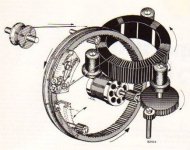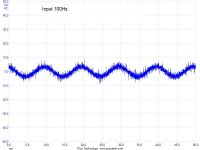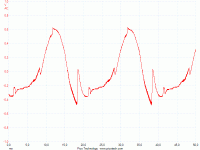Hi,
you should really reconcider making toroids from scratch; it is VERY timeconsuming to hand-wind a few hundred turns of wire on a toroid core! I have tried.
I tried cores that had a diam of about 120mm and it tok 40 minutes to wind one layer with about 100 turns. I was aiming for 800 turns and gave up after 4 hours.
There is a company that sells toroids prewound, and companies that has equipment to wind toroid cores per your specifications. Ask if they can provide cores complete with secondary windings and centertap and you can experiment with primaries. But then you can't interleave or sectionalize the windings.
You wont get the spool through the center - you will have to make a shuttle to carry the wire through the hole. Make the shuttle wide/narrow enought to pass through the hole when all wire is in place, and long enough to hold all the wire you need.
Imagine a piece sheet of plastic or wood cut in a H shape 1inch wide an 5-10 inch long..
(Just like the shuttle used for meding fishing nets)
I'll post a picture of how i did it later.
I just got a message that my new oscilloscope has arrived so I will test transformers tonight.
Regards
Bent
you should really reconcider making toroids from scratch; it is VERY timeconsuming to hand-wind a few hundred turns of wire on a toroid core! I have tried.
I tried cores that had a diam of about 120mm and it tok 40 minutes to wind one layer with about 100 turns. I was aiming for 800 turns and gave up after 4 hours.
There is a company that sells toroids prewound, and companies that has equipment to wind toroid cores per your specifications. Ask if they can provide cores complete with secondary windings and centertap and you can experiment with primaries. But then you can't interleave or sectionalize the windings.
You wont get the spool through the center - you will have to make a shuttle to carry the wire through the hole. Make the shuttle wide/narrow enought to pass through the hole when all wire is in place, and long enough to hold all the wire you need.
Imagine a piece sheet of plastic or wood cut in a H shape 1inch wide an 5-10 inch long..
(Just like the shuttle used for meding fishing nets)
I'll post a picture of how i did it later.
I just got a message that my new oscilloscope has arrived so I will test transformers tonight.
Regards
Bent
bentl,can't wait to see your results! last night i found a supplier for some raw toiridal cores. Toroidal Cores Stock I'm going to give them a call later.Their prices seem very reasonable compared to a compleatly wound core.
I don't mind winding one if it is big enough to get the spool of wire through the center.
You know bigger is better.
pn#120 for $22.52 at 1867VA come on! Maybe something even bigger.
I guess I have to lay out some guidelines because the sky is unlimited now. jer
Jerry,
Thanks for sharing the link!
I'm sure you probably already noticed that they also carry C-cores which are easier to wind than toroids, but a bit more expensive.
C-cores Stock
I gave the company a call and found out that the phenolic bobbins and cast metal bracket pictured with the C-cores are not included in the price listed on the web site. They need to be ordered separately. The bobbins are about $5 each and the base is about $7.50. The exact price will depend on what size core they are for.
thanks for the link jonas.I will look into building a toriod winder.
bentl, I have had many thoughts about this and I agree with you, however, I do have an extreme amount of patients when it comes to winding coils.
I have wound many many many small tesla coils by hand that were absolutely perfect and several times had to startover because one winding shifted half the way up.
Also the bigger the core the lesser amount of turns will be required depending on my lowest frequency and voltage range of operation.this has yet to be decided.
alpha core does offer winding services.
I didn't get to contact them today as i am tracking down hum and feedback loops in my system.
I'm hoping it is just the patch bay wrongly connected and/or dirty plugs and jacks.
There is a 1/4 of mile of cable in the thing and not in the mood to check every single individual cable.
But if I have to, I will.
Hopefully i'll be back testing by tonight.
It is always something,as I have been having this noise problem for quite sometime and needed to fix it anyway. jer
bentl, I have had many thoughts about this and I agree with you, however, I do have an extreme amount of patients when it comes to winding coils.
I have wound many many many small tesla coils by hand that were absolutely perfect and several times had to startover because one winding shifted half the way up.
Also the bigger the core the lesser amount of turns will be required depending on my lowest frequency and voltage range of operation.this has yet to be decided.
alpha core does offer winding services.
I didn't get to contact them today as i am tracking down hum and feedback loops in my system.
I'm hoping it is just the patch bay wrongly connected and/or dirty plugs and jacks.
There is a 1/4 of mile of cable in the thing and not in the mood to check every single individual cable.
But if I have to, I will.
Hopefully i'll be back testing by tonight.
It is always something,as I have been having this noise problem for quite sometime and needed to fix it anyway. jer
yes, Steve,they have C-Cores but I didn't see any prices for them.I need to figure out size per cost per range of operation. jer
Yeah, they didn't have a handy tabulation of costs for the C-cores like they did for the toroids.
You have to click on the link for the core size you are interested in at the top of the C-core page.
Links are the red blocks with white text showing core size.
CD25x50x100
Sitting here thinking......Wouldnt it be possible to use magnets from old scrapped bass drivers as toroid cores?
http://www.youtube.com/watch?v=zT8sJJZyKzc
http://www.youtube.com/watch?v=zT8sJJZyKzc
Sitting here thinking......Wouldnt it be possible to use magnets from old scrapped bass drivers as toroid cores?
It would be possible, but the maximum flux density before saturation is about 3 to 5 times lower for ferrite than for typical transformer iron. So, your core would need to be much larger than usual.
Last edited:
It would be possible, but the maximum flux density before saturation is about 3 to 5 times lower for ferrite than for typical transformer iron. So, your core would need to be much larger than usual.
True, but it would go higher in frequency, properly wound?
True, but it would go higher in frequency, properly wound?
The upper extent of the transformer bandwidth for ESL step-up transformers is not defined by the core material. It is a function of the leakage inductance, and the sum of the transformer winding capacitance and the ESL capacitive load. The leakage inductance is determined by winding geometry only, the core material has no effect on the leakage inductance. In fact, you can completely remove the core and the measured leakage inductance is the same.
Core losses are lower with ferrite cores at high frequencies, but this usually is only an advantage at frequencies much higher than 20kHz.
I fixed my ground problem today by lifting the ground on the mixer power supply.i don't like this but it works and i'll will investigate this further.
I haven't found any extra voltages or shock hazzard like i did before when it was connected.Go figure?
no hum and no noise except for resdidual noise, when all of the gain sections are compleately cranked no hum, just hiss!
when every thing is normalized it is dead silent,even with the amp fully cranked absolutely noise.
Whew! what a chore for something so simple!
Now I can start testing again and this time without any weird feedbacks coming from some where with nothing but the transformer connected.
It might have also been the reason my amp kept shutting down when theorectaly it didn't have a bad load hooked to it.Who knowes i'll find out later when I resume testing after i put it all back the way it was. jer
I haven't found any extra voltages or shock hazzard like i did before when it was connected.Go figure?
no hum and no noise except for resdidual noise, when all of the gain sections are compleately cranked no hum, just hiss!
when every thing is normalized it is dead silent,even with the amp fully cranked absolutely noise.
Whew! what a chore for something so simple!
Now I can start testing again and this time without any weird feedbacks coming from some where with nothing but the transformer connected.
It might have also been the reason my amp kept shutting down when theorectaly it didn't have a bad load hooked to it.Who knowes i'll find out later when I resume testing after i put it all back the way it was. jer
Sitting here thinking......Wouldnt it be possible to use magnets from old scrapped bass drivers as toroid cores?
You don't want a permanent magnet for a transformer. You would have to demagnetize the core before it would be useful. A magnetized core is saturated in one direction. Permanent magnets have been used in inductors that have a DC bias but that's another story.
New double stacked transformer!
Hi,
the first transformer is completed - almost..
Configuration:
Core: 20mm X 40mm X 116mm stacking height
Primaries: 45 turns X 3 in parallell
Secondaries: 2200 turns X 3 in series (winded with 2 wires in parallell to exactly locate the center)
State of operation: FAILURE!
For some reason it does not work, my first guess is that I have marked and swapped one of the primary or secondary windings.
(The picture is showing parts of the mess on my desk at the moment; the blue CD with "DIE RAUMKLANG" printed is a original STAX CD recorded with a artificial head. The box with BNC plugs is my PC oscilloscope with signal generator)
Well, better start measuring for shorts here..
regards,
Bent
Hi,
the first transformer is completed - almost..
Configuration:
Core: 20mm X 40mm X 116mm stacking height
Primaries: 45 turns X 3 in parallell
Secondaries: 2200 turns X 3 in series (winded with 2 wires in parallell to exactly locate the center)
State of operation: FAILURE!
For some reason it does not work, my first guess is that I have marked and swapped one of the primary or secondary windings.
(The picture is showing parts of the mess on my desk at the moment; the blue CD with "DIE RAUMKLANG" printed is a original STAX CD recorded with a artificial head. The box with BNC plugs is my PC oscilloscope with signal generator)
Well, better start measuring for shorts here..
regards,
Bent
Attachments
Hi,
the first transformer is completed - almost..
Configuration:
Core: 20mm X 40mm X 116mm stacking height
Primaries: 45 turns X 3 in parallell
Secondaries: 2200 turns X 3 in series (winded with 2 wires in parallell to exactly locate the center)
State of operation: FAILURE!
For some reason it does not work, my first guess is that I have marked and swapped one of the primary or secondary windings.
Two quick comments:
1) Very nice looking bobbin! and neat wiring & construction. You should be very proud of your work
2) Be sure to clamp the two halves of the E sections tightly together to minimize the airgap. Even small gaps in the magnetic circuit will lower the inductance and therefore the load impedance seen by the amplifier.
I usually test each primary separately to make sure each is working properly before hooking them up in parallel. It is also possible that you have some of the windings hooked together with opposite winding sense so that the voltages cancel.
Best of luck with your troubleshooting.
Found the problem with the transformer; poor connection in the screw terminals.¨
Getting some strange waveforms here. If I usen only one side of the center tap, output is fine, but using the full primary gives a strange looking waveform
Regards,
Bent
Getting some strange waveforms here. If I usen only one side of the center tap, output is fine, but using the full primary gives a strange looking waveform
Regards,
Bent
Attachments
Yes, I know this, but when used as a toroid, the magnetic flow is in a different direction?You don't want a permanent magnet for a transformer. You would have to demagnetize the core before it would be useful. A magnetized core is saturated in one direction. Permanent magnets have been used in inductors that have a DC bias but that's another story.
Yes, I know this, but when used as a toroid, the magnetic flow is in a different direction?
I've done a lot of transformer design but have never tired this. So I can't say it won't work but it conflicts with my understanding of how magnetic materials work. But I could be wrong.
If someone has actually done this, I would be interested to know.
- Status
- This old topic is closed. If you want to reopen this topic, contact a moderator using the "Report Post" button.
- Home
- Loudspeakers
- Planars & Exotics
- Step-up transformer design

![IMG_0016[1].jpg](/community/data/attachments/162/162148-70140ae4cce0ce71e08c9523dd98ffab.jpg)

